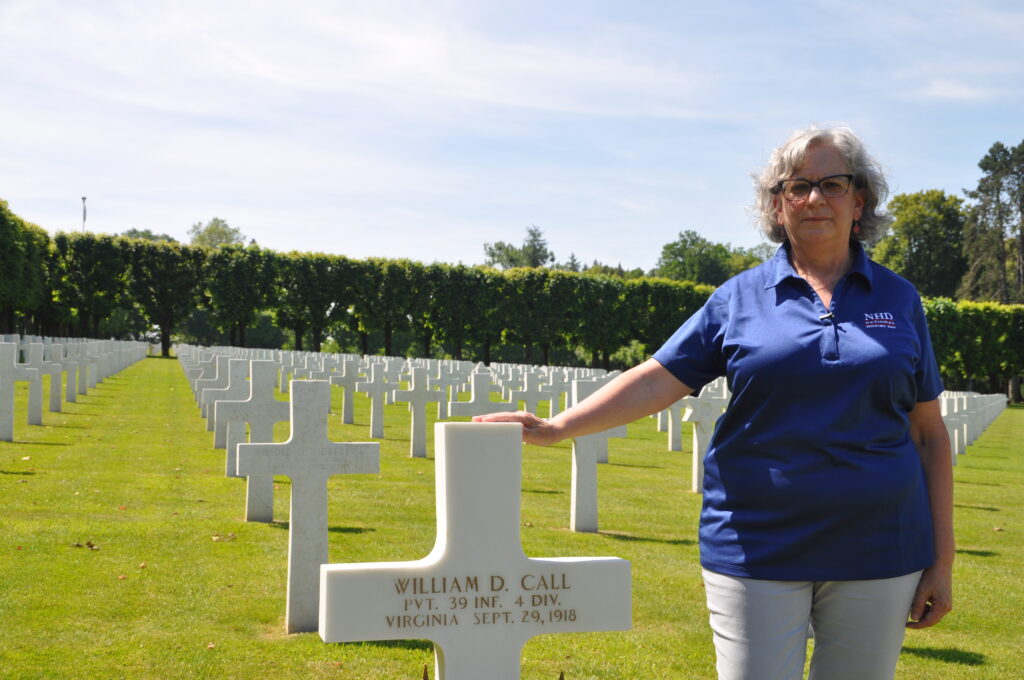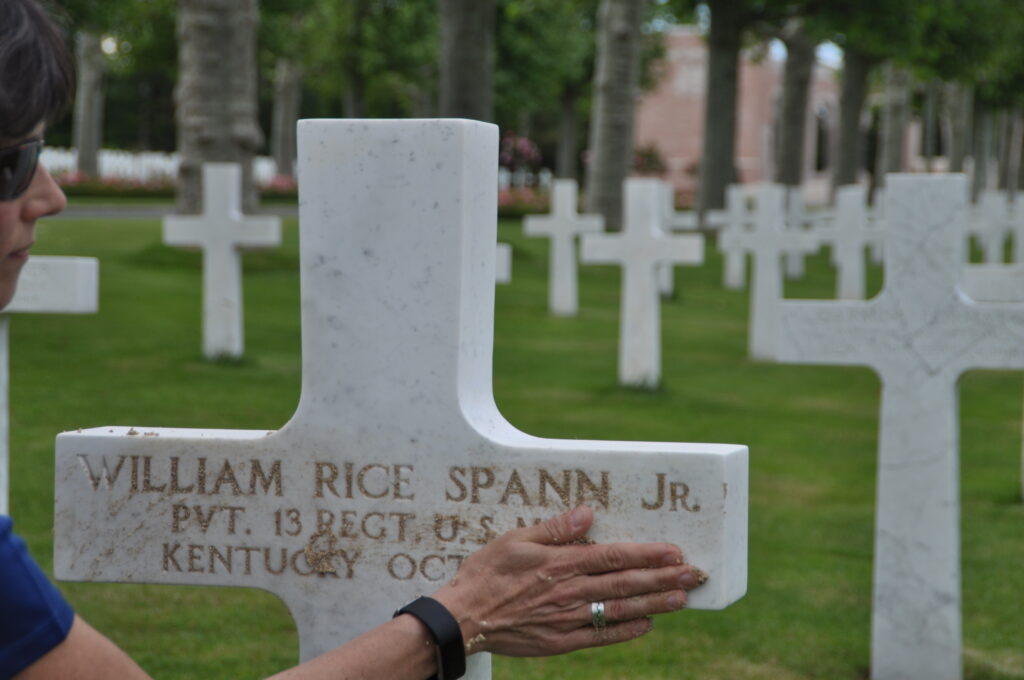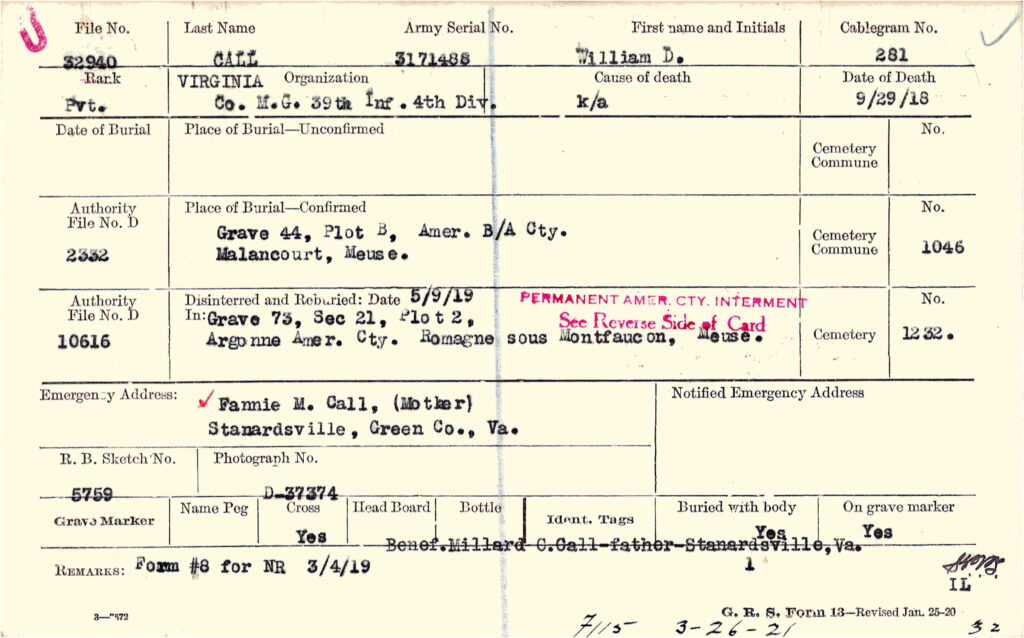Lynne M. O’Hara
National History Day
Many researchers and students of history have found themselves researching from home in the past year.
The challenges posed to students by the move to online learning and online research is something that the National History Day (NHD)organization decided to tackle directly. dedicated to improving the teaching and learning of history. We are best known for the NHD Contest, a program in which students in grades 6-12 select a topic, engage in historical research, and present their work as a paper, performance, exhibit, website, or documentary. Every year, thousands of students across the country get their first experience doing historical research, talking to library and archives professionals, interviewing historians and those who experienced the events they include in their projects.

Virginia teacher Stephanie Hammer at the grave of Private William D. Call at Meuse-Argonne American Cemetery in Romagne-Sous-Montfaucon, France. Read his story at nhdsilentheroes.org/william-denison-call. Photograph courtesy of Cathy Gorn.
In March 2020, like many other programs, we converted to a virtual format for affiliate (state) contests and our National Contest. For 2021 will be fully virtual again. Our students are operating in all types of school settings – live, virtual, and hybrid. We are very proud of the students and teachers working in challenging situations to complete and submit their projects to contests at the regional, affiliate, and the National Contest levels. This year’s theme, Communication in History speaks to the importance of technologies, language, and people in our nation.
While virtual research can present challenges, I would like to highlight the work that the NHD team has done to improve access and support virtual research. Our team focused on topics related to World War I and found that this topic offers students and researchers many opportunities to research virtually and engage with the large (and growing) number of digitized resources. From 2018 to 2020, National History Day partnered with the U.S. World War I Centennial Commission, the Pritzker Military Foundation, the American Battle Monuments Commission, and the National Cemetery Administration. We developed and published a series of resources and materials based on these resources to help students and grasp the war’s complexities and the legacies and impact that defined much of the following century. These resources (LINK), designed to inspire research and engage critical thinking skills in the classroom, are drawn from research conducted by dozens of teachers who worked with the program.
NHD staff, teachers, and educators have put together three online resources, some with their own independent research including Silent Heroes and others linked to publically available collections to assist students and their teachers on topics related to World War I.
Lesson Plan Book
NHD teachers developed a series of lesson plans for our lesson plan book, Great War, Flawed Peace, and the Lasting Legacy of World War I (LINK, click on “World War I Lesson Plans”). The digital book includes detailed information on the sources available for students and non-professional researchers interested in World War I
NHD developed its Silent Heroes program to tell the stories of service members who served and did not return home. We currently feature more than 200 men and women who served and died during WWI, WWII and the Korean War. (LINK) The research conducted by teachers as part of WWI centennial programs concluded with eulogies at the gravesites of these Silent Heroes. You can find the stories and the eulogies on the NHDSilentHeroes.org website.
The research has been an important contribution to knowledge about WWI veterans, for the teachers who participate in National History Day, and for the students who will use this research to create future NHD projects. Consider the story of U.S. Army Private Aaron Ray Griffin (nhdsilentheroes.org/aaron-ray-griffin). Indiana teacher Emily Lewellen researched his early life in Brown County, Indiana through his service with the 16th Infantry Regiment, 1st Division in France. Following a family tradition of service, Griffin enlisted in May 1917 and sailed to France on the USS Havana in June. She traced his experiences training in France, enduring the cold winter of 1917-1918, and his eventual death in the Battle of Soissons. She completed the research using sources available online, including Indiana census records, the Brown County History Center, and the Indiana Historical Society.

New Jersey school librarian Kate Spann placing sand in the headstone of U.S. Marine Private William Rice Spann, Jr., at Oise-Aisne American Cemetery in Seringes-et-Nesles, France. Read Private Spann’s story at nhdsilentheroes.org/william-rice-spann. Photograph courtesy of Cathy Gorn.
2020 led many people to look closely at their own family history. New Jersey school librarian Kate Spann researched U.S. Marine Corps Private William Rice Spann (LINK). She conducted her research using digitized resources available from the Library of Congress, the U.S. World War I Centennial Commission, the North Jersey History and Genealogy Center, as well as local newspapers, family records, and the American Battle Monuments Commission.
World War I Digital Resources, Archives, Museums, and Local History Resources
Cultural heritage institutions including archives, special collections, local history organizations and museums are increasingly bridging the divide to make more materials available to researchers who might never get to visit their facility. In doing so, they are reaching an even wider audience and sharing their collections with researchers far beyond their geographic scope.
One of the best starting points for any researcher is the National World War I Museum and Memorial (LINK). In Kansas City, Missouri, the museum houses a remarkable collection both on-site and in its digitized collections. The museum put many staffers to work digitizing and transcribing materials during COVID-closure in spring 2020. The online collections database (LINK) allows for various ways to search the collection. Are you looking for inspiration? Try a “random image” search on this website. You might be surprised by what you can find.
If a researcher wants to learn more about military history, the place to go is to the organizations that have the holdings of the U.S. military. In addition to materials housed by the National Archives, which has a new landing page for their military records (LINK), the U.S. Army Center of Military History’s World War I landing page (LINK) is an excellent source of published and archival materials. The new National Museum of the United States Army’s Nation Overseas online exhibit (LINK) is another valuable resource. The U.S. Army Heritage Center Foundation in Carlisle, Pennsylvania, offers a collection of Soldier Stories (LINK) including accounts from a World War I nurse, infantryman, and member of the “Polar Bear” expedition to Russia.
The Naval History and Heritage Command’s World War I page (LINK) includes links to documents, images, biographies, publications, and, of course, ships and aircraft used in the conflict. Researchers can also visit the National Museum of the Marine Corps’ World War I exhibit (LINK).

Wiliam Denison Call’s burial card from the National Archives and Records Administration (108999337).
Our teacher researchers found the following resources to be helpful for research on World War I Silent Heroes and veterans’ stories
- Chronicling America (LINK): a database of American newspapers from 1777-1963, sponsored by the National Endowment for the Humanities and the Library of Congress. This resource includes millions of pages of newspapers (and counting). These newspapers are keyword searchable, and the advanced feature allows you to narrow them down to papers in a particular state (or even a specific newspaper). Many local newspapers printed coverage reported by family members, and sometimes even letters sent home to families.
- World War I Burial Cards from the National Archives and Records Administration (LINK). These cards tell the stories of those killed during World War I. They contain information ranging from their assigned unit, cause of death, their next of kin, and the location where they are interred. These records are alphabetized but do require some searching. To learn more strategies to search the records, read Suzanne Zoumbardis’ blog post: LINK.
- American Battle Monuments Commission (LINK). After World War I, the federal government established the American Battle Monuments Commission to build and maintain the American military cemeteries overseas. Their searchable database (LINK) is a starting point for any researcher. Their cemeteries and memorials page (LINK) helps researchers learn more about the sites they maintain.
- World War I Images
- The National Archives and Records Administration’s (NARA) World War I photographs are a research starting point. As the repository for the permanently valuable records of the federal government, NARA holds thousands of World War I photographs, including Photographs of American Military Activities (LINK) and Historical Branch, War Plans Division Photographs (LINK). On each of these records, click “search within this series.” A NARA blog with search tips is very helpful: LINK.
- The Library of Congress Prints and Photographs Division’s World War I holdings (LINK) include various interesting research pathways. The holdings include newspaper photographs, panoramic photographs, political cartoons, posters, and stereograph cards. The Library’s online exhibition, Echoes of the Great War: American Experiences of World War I (LINK) is another excellent research starting point, highlighting primary and secondary resources, exhibition items, and multimedia.
- When researching the U.S. Navy or U.S. Marine Corps’ history in World War I, Naval History and Heritage Command (LINK) has searchable, high-quality images available to researchers. It is easy to search and contains an extensive (and growing) digitized collection.
In the research process, do not overlook state and local historical societies. While these organizations’ online presence varies greatly, many searched their collections for the centennial to display World War I artifacts for local and state exhibitions. Check it out – you might be pleasantly surprised by what you find.
In addition to local resources, think about expanding beyond American repositories.
- The National Archives of the United Kingdom – First World War 100 (LINK) and Digitised First World War Records (LINK);
- The British Library’s World War One Landing Page (LINK);
- The Imperial War Museum’s (London) First World War Page (LINK);
- The National Archives of Australia’s records (LINK); and
- Archives New Zealand’s World War I Research Guide (LINK).
When you research digitally, remember to work with different search strategies. When an advanced search feature is available, use it! Try a variety of keywords, and stick with it. Often it takes several searches or a refined search to narrow down to results that you can use.
And let me add, if you have a passion for history, please consider connecting with your local NHD coordinator (nhd.org/affiliates). NHD contests at the regional, affiliate, and national level are always looking for judges. Judges (nhd.org/judges) do not need to be experts in any fields of history, but they need to be adults who are willing to evaluate student work and provide feedback to help them improve their research and presentation skills. You might be just the person who inspires a future historian or engaged citizen.
(Return to May 2021 Table of Contents)
